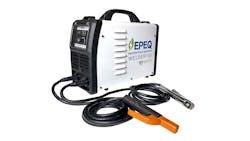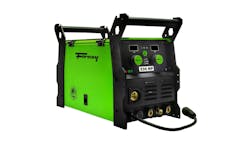Welding equipment advancements help shops stay ahead of welder shortage
One of the biggest challenges in today’s welding labor market is a lack of skilled candidates. The American Welding Society estimates that the U.S. will need 360,000 new welding professionals by 2027, while at the same time, an estimated 155,000 welders, nearly 20% of the industry’s current workforce, are nearing retirement. It's no surprise that body shops find it a challenge to hire new talent.
“The industry is feeling the repercussions of the last several years or even decades where there was an enormous emphasis on our youth coming out of high school and going into colleges, and there was a significant drain on people going into the trades, like welding and welding technology,” said Dean Strathman, VP of sales at Vanair. “The amount of people who are trained in that is far less than what it would have been in the past. So, there’s a need for a much simpler product to work with.”
To adapt to these shifts, body shops are embracing new welding technologies. The welding shortage has been known for several years, with welding equipemt manufacturers such as Lincoln Electric and Miller Electric employing virtual and augmented reality solutions to train new and experienced welders faster and safer. Because they are not working with live arcs, newcomers can learn proper techniques and motions, gaining confidence before using the real thing. The machines also collect metrics to track scores and progress.
Both companies have even come out with mobile versions of their classroom training simulators. Miller's is called the MobileArc Augmented Reality Welding System, while Lincoln has the VRTEX 360 Compact.
But simulators won't fix a bent liftgate or seal an exhaust pipe. The actual welding equipment used in the field also needs to be more user-friendly, and recent developments meet this need. The release of highly efficient welding devices have made it easier to learn how to weld and for experienced workers to expand their skills. And reciprocally, the resulting advancements in safety and multifunctionality are transforming today’s welders and technicians as well.
Emerging welding technologies
Some of the latest welding developments simply take existing technologies and improve their functionality to be more efficient and versatile. Others, such as robotic welding, are still in development but have gained interest among industry pros.
Multi-process welding equipment
One way welding tech developers are improving existing tools is by investing in multi-process and multifunction welding equipment. By allowing a technician to perform quick welds almost anywhere, these devices are ideal for smaller body shops or a mobile welding unit with fewer employees on hand.
Vanair was an early innovator in the multi-process and multifunction welding niche following its acquisition of Air N Arc in 2009. Now, Donnie Stone, director of training and technical publications at the company, explained the several applications that can be packed into a single multi-process unit.
“Multi-process welding [is] capable of providing not just traditional arc welding or stick welding, but MIG welding capabilities, TIG welding capabilities, as well as air gouging,” Stone said. “It also has the multifunction side of it, too, meaning it gives multiple forms of power out of a single, engine-driven piece of equipment.”
Vanair’s ALL-IN-ONE power systems are a great example of the type of multi-processing welding devices gaining popularity today. The ALL-IN-ONE 330 Diesel, a collaboration with Lincoln Electric, includes stick, TIG, MIG, FCAW, and air gouging welding capabilities. It can be used as an air compressor, power generator, and mobile EV charger as well.
Demand for electric and battery-powered welding equipment is also on the rise, particularly for mobile power equipment. This could be due to low- and zero-emissions initiatives, but for some users, a battery-powered system is more versatile or logistically feasible than a diesel-powered one.
For a combination of both multi-process and zero-emissions equipment, commercial vehicle companies with EVs can get an electric multi-process welder like Vanair’s EPEQ WELDER140 with a zero-emissions repair kit. This allows fleets to eliminate emissions throughout their vehicles and operations without relying on diesel.
Laser Welding
Laser welding is another major development in the commercial vehicle industry. This technology has been around for several years now, but it’s increasingly coming to the forefront as a potential solution for skills shortages due to its ease of use.
“I personally have been exploring laser welding, as a novice can pick up a laser welder and put down good welds within a day versus the years of experience it takes [to learn] traditional welding methods,” said Brian Joseph, operations coordinator at Fleet Fast, a commercial vehicle body repair shop. “It shows potential to greatly impact our team of fabricators and speed up the tech training process.”
Read more: The case for ergonomic welding
Laser welding is also faster than MIG welding and produces stronger welds, allowing new welders to get up to speed quicker with fewer worries about poor-quality work creating safety or mechanical concerns. Additionally, laser welders can be multifunctional. For instance, a technician could use the same handheld tool to do quick welds, clean rust off their vehicle, and even cut metal. Portable laser welding takes this versatility a step further by allowing technicians to perform speedy, durable work in the field.
Assistive technologies
Another innovation for welders is assistive technologies designed to help technicians work more efficiently or safely. This includes tech-like collaborative robots as well as mechanical and software-based tools.
Many welders already use positioning equipment, which reduces injury risks and improves ergonomics at welding stations. But positioners can also increase weld strength and quality, since they helps workers maintain angle and distance consistency while being convenient and efficient. For instance, a positioner helps a welder save time on a circular weld by letting them complete the job without stopping and starting to manually rotate the part they’re working on.
While 3-axis positioners have been common in the industry for years, more advanced 5-, 6-, and 7-axis versions are hitting the market to support automated welding’s growth.
Collaborative welding robots
One reason welding positioners are gaining popularity is due to the rise of another applied innovation, albeit one still in development: robotics. There’s been some exciting growth in the welding robot market over recent years, including more user-friendly collaborative models, which emphasize safety alongside efficiency.
For instance, the Cooper Welding Cobot designed by Lincoln Electric has advanced safety features and features a user-friendly interface. The device will automatically stop when someone makes contact with it to prevent accidents, while welders can program the robot without any coding experience. They can simply drag and drop icons or manually move the cobot’s six-axis robotic arm.
This might seem only useful for repeatable proesses in a factory, but according to a Lincoln spokesperson, "some parts/ components can be programmed to sense and/or scan to repair and/or weld" in the vehicle maintenance space.
The Cooper welding cobot was used:
- for multi-pass welding
- to hit difficult angles/ inconsistencies of joined parts
- for seam tracking (Thru-Arc Seam tracking)
In addition, industrial customers have used the cobot to aid in heavy-duty part fabrication.
Many body shops have not yet adopted welding robots, but Fleet Fast's Joseph is keeping an eye on this technology.
“Robotic welding has the potential to revolutionize body shops in terms of efficiency and precision,” Joseph explained. “[It] can increase consistency in weld quality and speed up the repair process, which can be particularly beneficial for large fleet customers who require quick turnaround times. However, it's essential to balance automation with the expertise and craftsmanship of our skilled technicians, as the human touch remains crucial in many aspects of repair work.”
Cobots may well emerge as the solution to balance human expertise and robotic assistance. Rather than purely automating the welding process, these devices allow welders to automate certain aspects of their jobs while still guiding their work with their experience, knowledge, skills, and creativity.
How body shops can benefit from new welding tech
While these new technologies can be beneficial for body shops, both the commercial vehicle industry and technology developers are still discovering how to maximize their efficiency. This means shops and manufacturers may need to have a flexible approach to integrating their technology and human talent.
“As manufacturing moves more and more toward automation, designs will be more and more designed for it as well,” said Josh Zuckerman-Erd, a welding product engineer at Forney. "This can change how easy things are to work on both for the better and for the worse.”
For instance, assistive technologies and more versatile welding gear are effectively more capable, user-friendly versions of tools the industry is already used to and could find a place in your typical maintenance shop.
In contrast, robotics and automated tools will be more challenging to adapt to but offer great benefits. Collaborative welding robots are easy to work with, take advantage of individual welders’ expertise, include extensive safety features, and improve weld quality. This makes them more helpful in body shops than in other applications, particularly for repetitive repairs and parts that require tight tolerances, Zuckerman-Erd noted.
By paying attention to how these developments best fit into their workflow, commercial vehicle body shops will reap greater rewards and mitigate the effects of the labor shortage as this technology becomes more accessible and affordable. All that’s required is balancing technological efficiency with the skills and expertise of their welding specialists.
About the Author

Ellie Gabel
Associate Editor
Ellie Gabel is a science writer specializing in astronomy and environmental science and is the Associate Editor of Revolutionized. Ellie's love of science stems from reading Richard Dawkins books and her favorite science magazines as a child, where she fell in love with the experiments included in each edition.



